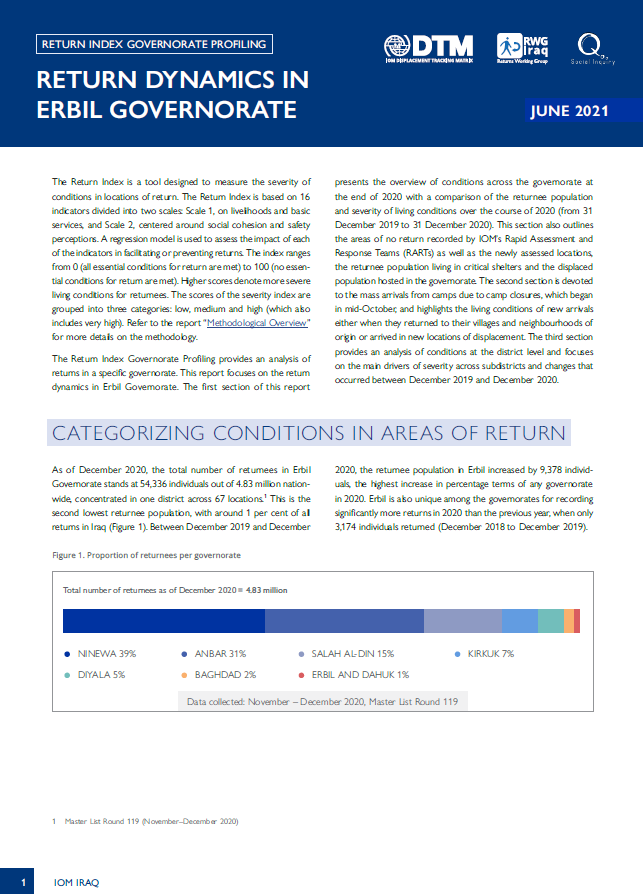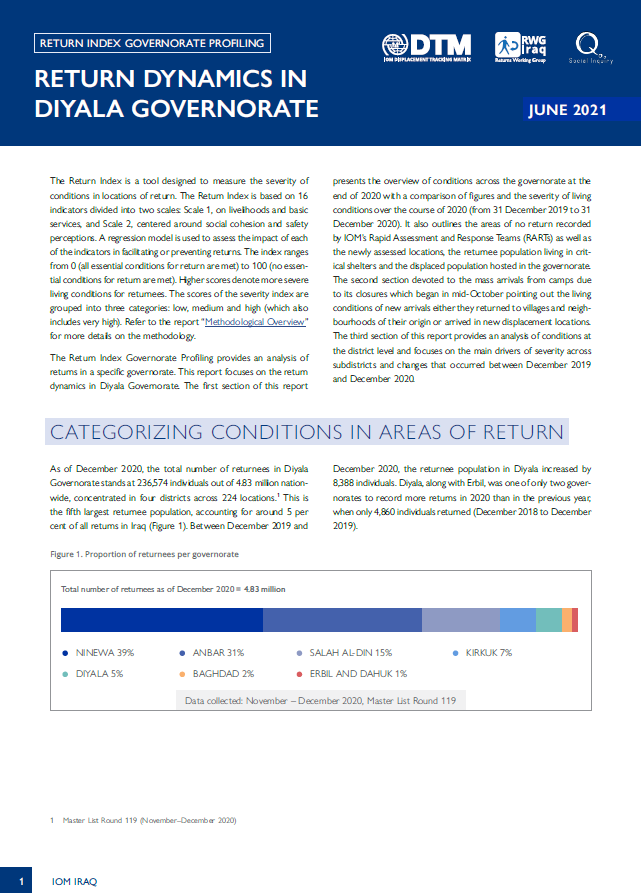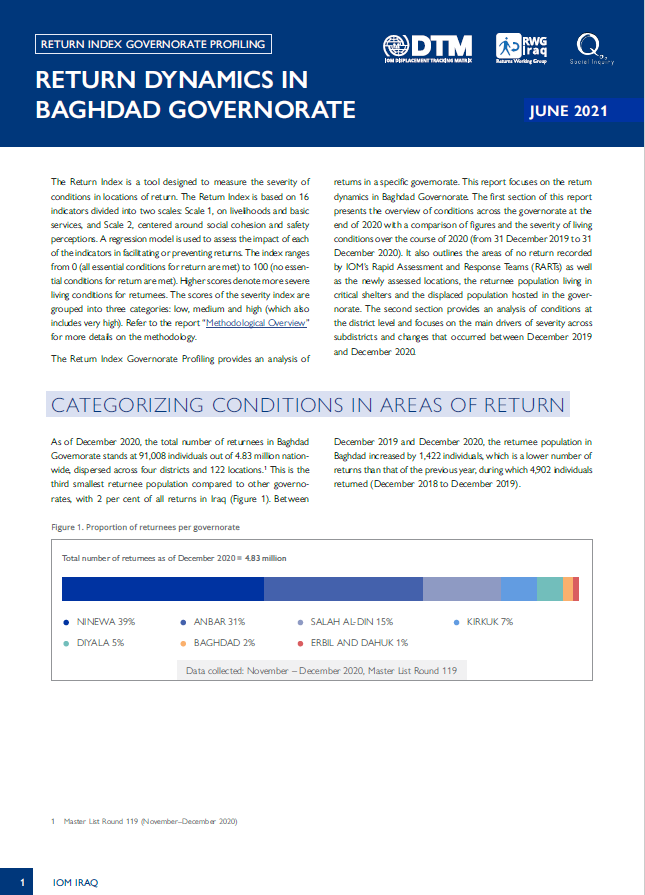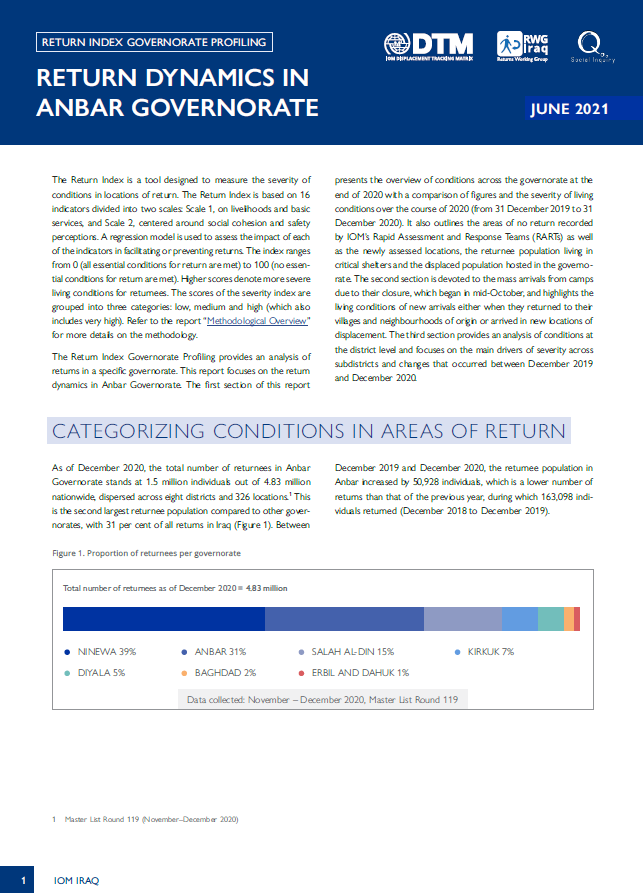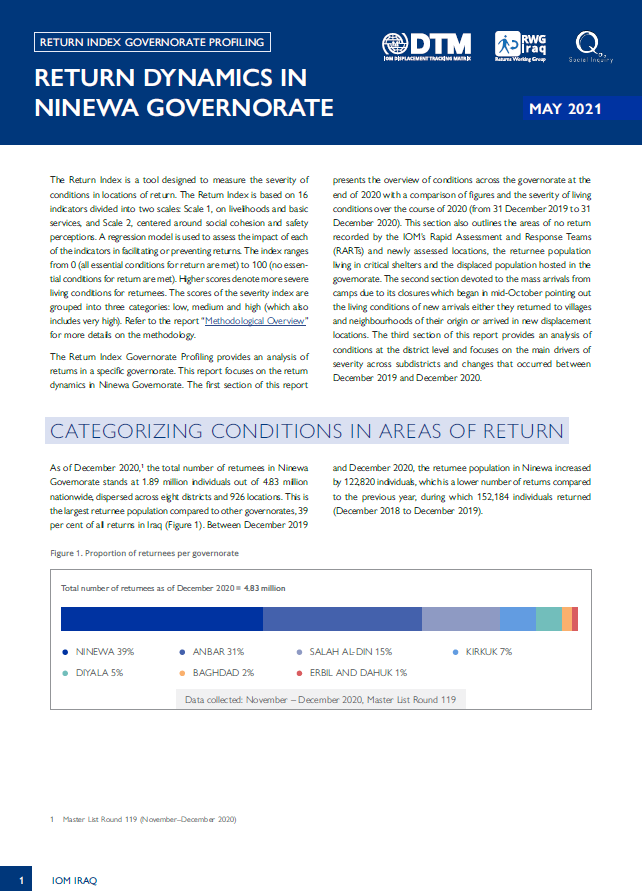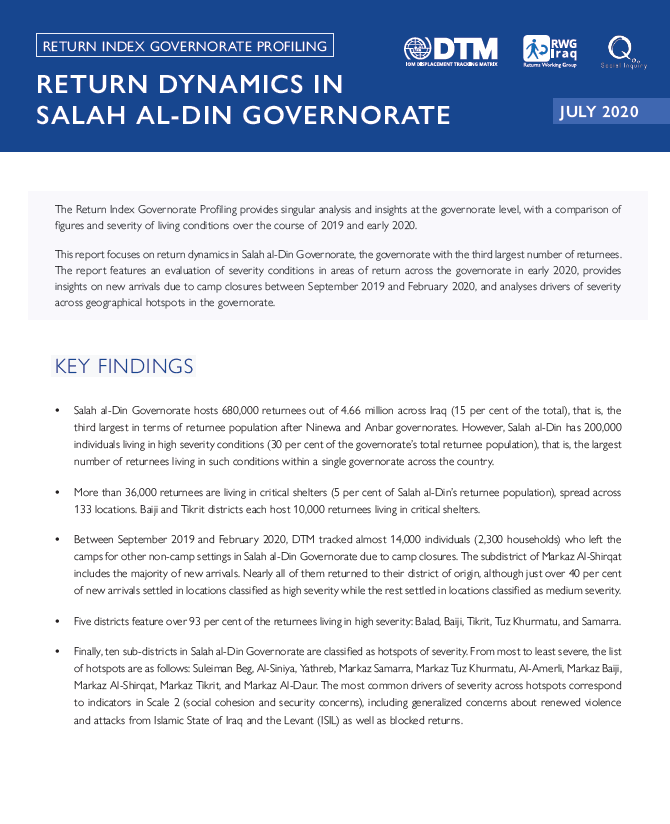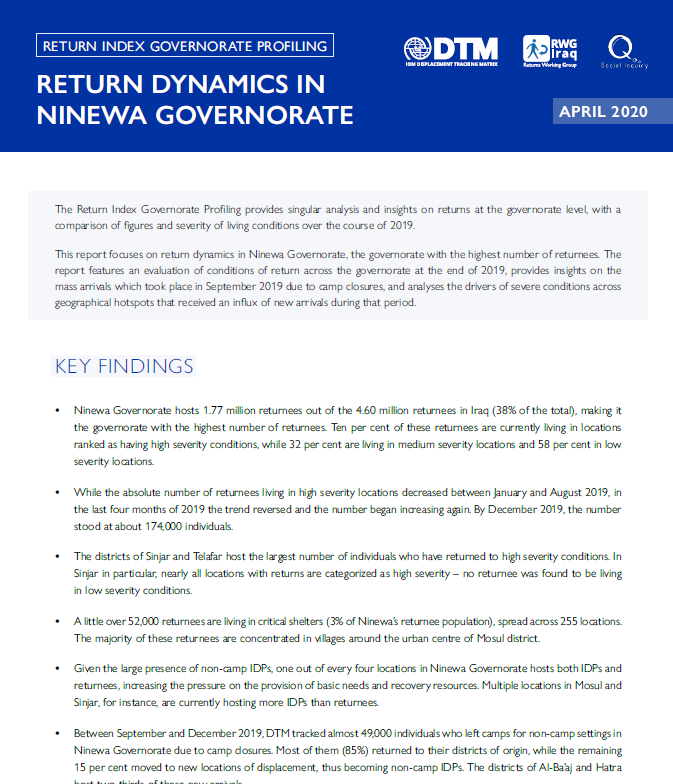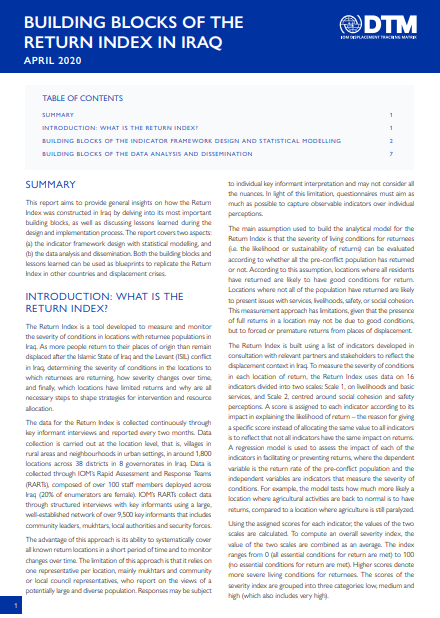Return Index Reports
























Thematic Reports









Return Index Datasets
METHODOLOGICAL OVERVIEW - IRAQ
This document presents a short overview of the methodology and guiding principles of the Return Index. Further details on how the Return Index was constructed in Iraq by delving into its most important building blocks, as well as discussing lessons learned during the design and implementation process, are available in the report “Building Blocks of the Return Index in Iraq”.
BUILDING BLOCKS OF THE RETURN INDEX IN IRAQ
This report aims to provide general insights on how the Return Index was constructed in Iraq by delving into its most important building blocks, as well as discussing lessons learned during the design and implementation process. The report covers two aspects: (a) the indicator framework design with statistical modelling, and (b) the data analysis and dissemination. Both the building blocks and lessons learned can be used as blueprints to replicate the Return Index in other countries and displacement crises.
As more people return to their places of origin than remain displaced in Iraq, it is necessary to know the severity of conditions in the locations to which they are returning, how this changes over time, and finally, which locations have limited returns and why, to shape strategies for intervention and resource allocation.
While population and location figures highlight the significant number of people in Iraq who may be in need of assistance upon return, they do not shed light on what type of assistance is needed, who needs it, and where, to prevent secondary displacement or prolonged residence in poor physical and/or social conditions.
Thus, a more precise tool is needed to understand the ‘quality of returns’ in Iraq and to this end IOM DTM, the Returns Working Group, and Social Inquiry developed the Return Index. This tool serves as a means of measuring severity of conditions in areas of return to allow partners to better strategize for resources and operations in vulnerable areas or to mitigate risks of push/pull factors for a more specific set of coherent interventions that bridge humanitarian, recovery, and stabilisation needs.
To measure the severity of conditions in each location of return, the Return Index is based on 16 indicators grouped into two scales:
(i) livelihoods and basic services,
(ii) social cohesion and safety perceptions.
A regression model is used to assess the impact of each of the indicators in facilitating or preventing returns and to calculate scores for two scales. For example, the model tests how much less likely a location where no agricultural activities have recovered is to have returns compared to a location where these activities have recovered.
To compute an overall severity index, the scores of the two scales are combined. The index ranges from 0 (all essential conditions for return are met) to 100 (no essential conditions for return are met). Higher scores denote more severe living conditions for returnees. The scores of the severity index can be grouped into three categories: ‘low’ severity conditions, ‘medium’ and ‘high’ (which also includes the identified ‘very high’ locations).
Response options of 16 indicators also can be grouped into three categories of severity: 'low', 'medium' and 'high'.
|
SCALE 1:
LIVELIHOODS AND BASIC SERVICES |
CATEGORY
OF SEVERITY |
|---|---|
| Recovery of agriculture | |
| Most or all agricultural and/or livestock activities are taking place as before | Low |
| Some of the agricultural and/or livestock activities are taking place as before | Medium |
| None of the agricultural and/or livestock activities are taking place as before | High |
| Location does not have agricultural land | Not applicable |
| Recovery of businesses | |
| Most or all businesses are open | Low |
| Some businesses are open | Medium |
| None of the businesses are open | High |
| Not applicable, there is no business in location | Not applicable |
| Employment access | |
| Most or all residents can find employment | Low |
| Around half the residents can find employment | Low |
| Less than half the residents can find employment | Medium |
| None of the residents can find employment | High |
| Access to markets for basic items and food | |
| It is easy to access basic items and food | Low |
| It is difficult to access basic items and food | Medium |
| It is not possible to access basic items and food | High |
| Provision of government services | |
| Most or all government services are being provided | Low |
| Some of the services are being provided, but not all | Medium |
| None of the government services are provided | High |
| Not applicable, there are no government services in location | Not applicable |
| Electricity sufficiency | |
| Most or all residents have enough electricity | Low |
| Only some of the residents have enough electricity while others do not | Medium |
| None of the residents have enough electricity | High |
| Water sufficiency | |
| Most or all residents have enough water | Low |
| Only some of the residents have enough water while others do not | Medium |
| None of the residents have enough water | High |
| Residential destruction | |
| More than half the houses are destroyed | High |
| About half the houses are destroyed | Medium |
| Less than half the houses are destroyed | Medium |
| None of the houses are destroyed (they all have been reconstructed) | Low |
| Housing reconstruction status | |
| None | High |
| Yes, many | Low |
| Yes, a few | Medium |
| Not applicable (no destruction) | Not applicable |
| Access to primary school | |
| Most or all can access schooling | Low |
| Only some of the children can access schooling while others cannot | Medium |
| None of the children can access schooling | High |
| Access to health center | |
| Most or all can access primary health care | Low |
| Only some of the children can access primary health care while others cannot | Medium |
| None of the children can access primary health care | High |
|
SCALE 2: SAFETY AND SOCIAL COHESION |
CATEGORY OF SEVERITY |
|---|---|
| Concerns_UXOs | |
| Very concerned | High |
| Somewhat concerned | Medium |
| Not concerned | Low |
| Concerns_security forces or armed groups | |
| Very concerned | High |
| Somewhat concerned | Medium |
| Not concerned | Low |
| Concerns_ISIL attacks | |
| Very concerned | High |
| Somewhat concerned | Medium |
| Not concerned | Low |
| Concerns_harassment at checkpoints | |
| Very concerned | High |
| Somewhat concerned | Medium |
| Not concerned | Low |
| Concerns_revenge acts | |
| Very concerned | High |
| Somewhat concerned | Medium |
| Not concerned | Low |
| Concerns_ethno-religious or tribal tensions | |
| Very concerned | High |
| Somewhat concerned | Medium |
| Not concerned | Low |
| Not applicable, there is only one tribe/ethno-religious group | Low |
| Multiple or no security actors | |
| 0 | High |
| 1 | Low |
| 2 | Low |
| 3 | Low |
| 4 | High |
| 5 | High |
| 6 | High |
| Presence of other security actors | |
| Yes | Medium |
| No | Low |
| Movement restriction | |
| The restrictions have a big impact | High |
| The restrictions have a little impact | Medium |
| The restrictions have no impact | Low |
| Not applicable, there are no restrictions | Low |
| Daily public life | |
| Streets are busy with residents carrying out daily activities and it feels calm | Low |
| Streets are busy with residents carrying out daily activities but it feels tense | Medium |
| Residents leave their homes only when they have to and streets are sparsely populated | High |
| Community reconciliation | |
| Reconciliation is needed AND NOT taking place | High |
| Reconciliation is needed and taking place / Reconciliation is not needed | Low |
| Illegal occupation of private residences | |
| No | Low |
| Yes, many | High |
| Yes, few | Medium |
| I don’t want to answer | Medium |
| Access to offices for civil justice matters | |
| Yes | Low |
| No | High |
| Blocked returns | |
| None | Low |
| Yes, many | High |
| Yes, few | Medium |
| I don’t want to answer | Medium |

